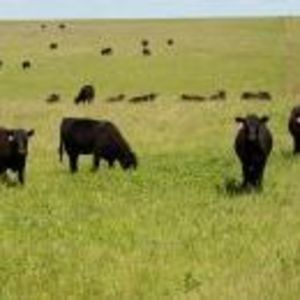KSU: DDGS plus salt boosts weight gain in beef cattle

Kansas State University
April 23, 2015
BY Kansas State University
A recent Kansas State University study found that providing growing cattle with dried distillers grains (DDGS) plus salt on a self-feeding basis while the animals grazed native pastures helped boost average daily weight gain without the indirect expenses linked to daily delivery such as fuel and labor.
During the two growing seasons prior to the 2013 study, the Flint Hills area of Kansas, like much of the state, experienced drought which stressed pastures.
Looking for ways to optimize cattle performance and maintain pasture health, a team of K-State researchers conducted a study with beef heifers over a 78-day period at K-State’s Beef Stocker Unit in the northern Flint Hills. While grazing, some of the heifers had access to DDGS mixed with salt at two different levels.
DDGS are a byproduct of ethanol production and are commonly fed to beef cattle, particularly in areas where ethanol is made. Most ethanol is derived from corn, but can also be made from other feedstocks such as sorghum or wheat.
Advertisement
“We have known for several years that DDGS is a good source of protein and energy when fed as a supplement for cattle,” said Dale Blasi, extension beef specialist with K-State Research and Extension. “In this study we wanted to determine the consumption and resulting growth from supplemental DDGS when provided at two levels of salt addition.”
“Salt limits the intake of DDGS,” said Blasi, who led the research team. “The more salt that is included, the less DDGS is consumed.”
The cattle were split into three grazing “treatments,” each consisting of four pasture paddocks. Heifers in the control paddocks (85 head total) were fed no DDGS with salt, while heifers in the “low” paddocks (94 head) had access to DDGS with 10 percent salt. Heifers in the “high” paddocks (100 head) had access to DDGS with 16 percent salt.
Advertisement
The cattle in the control paddocks had an average daily weight gain of 1.91 pounds over the 78-day grazing period. Those in the “low” paddocks that consumed DDGS with 10 percent salt had an average daily gain of 2.62 pounds and those in the “high” paddocks with access to DDGS with 16 percent salt gained an average 2.41 pounds.
Cattle in the “low” treatment paddocks consumed approximately 3 pounds per day more DDGS than their counterparts in the “high” group consumed.
“This supports the idea that providing DDGS with salt in a self-fed fashion can be used to improve cattle performance without the indirect expenses associated with daily delivery, such as fuel expenses, labor, and others,” Blasi said. “Providing DDGS to cattle on native grass at about 0.3 percent of body weight will significantly improve performance.”
More information on the study is available online at Cattlemen’s Day 2014.
Related Stories
The U.S. exported 31,160.5 metric tons of biodiesel and biodiesel blends of B30 and greater in May, according to data released by the USDA Foreign Agricultural Service on July 3. Biodiesel imports were 2,226.2 metric tons for the month.
CARB on June 27 announced amendments to the state’s LCFS regulations will take effect beginning on July 1. The amended regulations were approved by the agency in November 2024, but implementation was delayed due to regulatory clarity issues.
Legislation introduced in the California Senate on June 23 aims to cap the price of Low Carbon Fuel Standard credits as part of a larger effort to overhaul the state’s fuel regulations and mitigate rising gas prices.
The government of Brazil on June 25 announced it will increase the mandatory blend of ethanol in gasoline from 27% to 30% and the mandatory blend of biodiesel in diesel from 14% to 15%, effective Aug. 1.
The U.S. EIA reduced its 2025 and 2026 production forecasts for a category of biofuels that includes SAF in its latest Short-Term Energy Outlook, released June 10. The forecast for 2025 renewable diesel production was also revised down.
Upcoming Events









